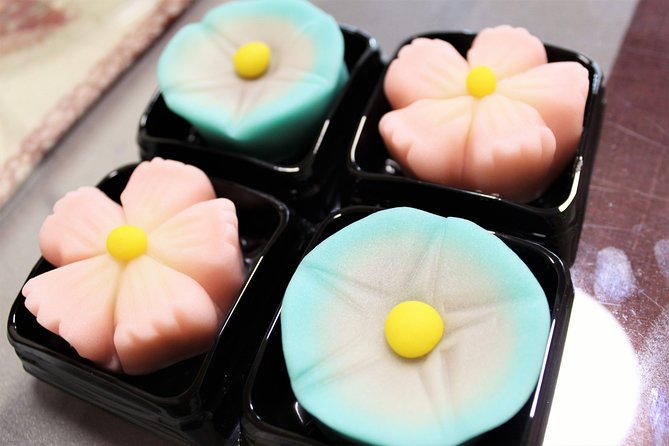Japanese Sweets Making With Seasonal Motifs
Japanese sweets making embraces seasonal motifs, allowing home bakers to connect with nature while crafting beautiful confections. With a focus on budget-friendly techniques, you can utilize fresh, seasonal ingredients to create visually appealing treats that reflect the essence of each season. Understanding the cultural significance behind these sweets enriches the baking experience, providing insights into Japanese traditions. As they explore the art of wagashi and its traditional tools, they might wonder how to best pair these creations with beverages for a complete experience. What techniques will enhance their seasonal baking journey?
Key Points

- Seasonal motifs in Japanese sweets are inspired by nature, with designs reflecting elements like cherry blossoms in spring and vibrant leaves in autumn.
- Artisans use simple molds and natural dyes to create visually appealing sweets that celebrate seasonal themes.
- Incorporating seasonal ingredients enhances both the flavor and aesthetic of the confections, deepening cultural significance.
- Engaging with seasonal elements in sweet-making fosters a richer appreciation for Japanese culinary traditions and craftsmanship.
- Pairing these seasonal sweets with appropriate teas amplifies the overall tasting experience and highlights cultural connections.
It's also worth checking out some other tours and experiences nearby.
Seasonal Ingredients in Japanese Sweets

Seasonal ingredients play a crucial role in Japanese sweets, as they reflect the changing flavors and aesthetics of each season, offering a unique tasting experience that connects people to nature and tradition. By using ingredients like sakura in spring or chestnuts in autumn, makers emphasize the beauty of nature’s cycles.
For budget-conscious individuals, exploring local markets can be a treasure trove for fresh, seasonal produce at lower prices. Plus, many recipes require minimal ingredients, making it easy to replicate these sweets at home.
Embracing the seasons not only enhances the flavor but also deepens one’s appreciation for Japanese culture. By incorporating seasonal ingredients, anyone can create delightful treats that celebrate Japan’s rich culinary heritage without breaking the bank.
The Art of Wagashi
Wagashi, the traditional Japanese sweets, showcase meticulous craftsmanship and a deep connection to the seasons, making them both a visual delight and a tasty treat that anyone can learn to create at home.
These delicate confections, often made from simple ingredients like rice flour and red bean paste, allow for creative expression and seasonal themes.
For beginners, starting with basic shapes like cherry blossoms or autumn leaves is a great way to embrace the art of wagashi.
Using natural food colors or edible flowers can enhance visual appeal without breaking the bank.
Plus, local Japanese markets often offer affordable ingredients.
Embracing this art form not only nurtures creativity but also deepens one’s appreciation for Japan’s rich culinary traditions.
Traditional Techniques and Tools
Mastering traditional techniques and tools is essential for anyone looking to create authentic Japanese sweets, as these methods reflect centuries of culinary artistry and cultural significance. Using the right tools not only enhances the process but also connects makers to the rich history of Japanese confectionery.
| Tool | Purpose | Budget Tip |
|---|---|---|
| Tsubaki (Mold) | Shapes sweets into beautiful forms | Look for second-hand options! |
| Shamoji (Spoon) | Mixes ingredients evenly | Use a wooden spoon as an alternative |
| Suribachi (Mortar) | Grinds ingredients for flavors | Explore kitchen stores for affordable finds |
| Kiri (Knife) | Cuts delicate sweets precisely | Invest in a versatile kitchen knife |
Step-by-Step Sweet Making
Using traditional tools and techniques, participants can follow a straightforward process to create exquisite Japanese sweets that reflect Kyoto’s rich culinary heritage.
First, they’ll measure ingredients precisely, ensuring the perfect balance of flavors. Next, they’ll knead and shape the dough, using simple yet effective methods. Each step emphasizes care and attention, enhancing the sweet’s delicate texture.
Participants can also learn to incorporate local ingredients, such as matcha or red bean paste, providing a unique twist while staying budget-friendly.
They’ll enjoy their creations with a warm cup of tea or coffee, making the experience even more delightful. This hands-on approach not only fosters culinary skills but also deepens appreciation for Kyoto’s sweet-making traditions.
Seasonal Motifs in Design
Many artisans draw inspiration from the changing seasons to create visually stunning designs in their Japanese sweets, reflecting nature’s beauty and cultural significance.
For example, cherry blossoms in spring inspire delicate pink confections, while autumn brings rich hues of orange and gold, mirroring the changing leaves.
Artisans often use seasonal ingredients, like sweet potatoes in fall or fresh fruit in summer, enhancing flavors and aesthetics.
To recreate these motifs at home, one doesn’t need expensive tools; simple molds or natural dyes from fruits can transform sweets into seasonal delights.
Engaging with the seasons not only elevates the dessert experience but also deepens one’s appreciation for Japanese culture, making it a joyful, budget-friendly endeavor for everyone.
Pairing Sweets With Beverages
Pairing traditional Japanese sweets with the right beverage can enhance their delicate flavors and create a delightful tasting experience. Here are three budget-friendly suggestions for perfect pairings:
-
Matcha Tea: The earthy bitterness of matcha complements the sweetness of mochi, creating a balanced palate.
-
Genmaicha: This toasted rice green tea’s nutty profile pairs wonderfully with sweet red bean pastries, bringing out their rich flavors.
-
Hojicha: Its roasted notes work well with lighter sweets like sakura mochi, allowing the floral essence to shine through.
These combinations not only elevate the enjoyment but also offer a glimpse into Japanese culture and culinary traditions.
Experimenting with different beverages can lead to new favorites, making every tasting experience unique and memorable.
Cultural Significance of Sweets
Japanese sweets hold a rich cultural significance, often reflecting seasonal changes and traditional festivals that celebrate the country’s heritage. Each sweet, known as wagashi, is crafted with care, symbolizing nature’s beauty and the passage of time.
For example, sakura-shaped sweets are popular during cherry blossom season, while chestnut treats herald autumn’s arrival. These confections aren’t just desserts; they foster community and connection during celebrations like the New Year and Moon Viewing.
Tips for Home Baking
Embracing the art of making wagashi at home can bring the joy of Japan’s sweets culture into your kitchen, allowing anyone to celebrate seasonal ingredients and traditions affordably.
To get started, here are some practical tips:
-
Use Fresh Ingredients: Seasonal fruits and local beans enhance flavor and authenticity. Visit local markets for the best finds.
-
Master the Basics: Start with simple recipes like mochi or anko. These foundational skills will make more complex sweets easier.
-
Invest in Tools: You don’t need fancy equipment; a rolling pin, a sieve, and molds can suffice. Affordable options are available online or at kitchen stores.
With these tips, anyone can enjoy the delightful process of creating traditional Japanese sweets right at home.
Here's a few more nearby tours and experiences we think you'll like.
Questions You May Have
What Is the Best Time to Learn Sweets Making in Kyoto?
The best time to learn sweets making in Kyoto is during spring or autumn. Seasonal ingredients enhance flavors and provide cultural insights, making the experience rich and memorable. Plus, the scenery’s breathtaking during these times!
Are There Age Restrictions for Participants in the Sweets-Making Experience?
The experience welcomes participants aged six and older, requiring adults to accompany younger children. It’s a fantastic opportunity for families to bond while exploring Kyoto’s rich confectionery traditions together, creating delightful memories and treats.
Can We Customize the Sweets We Make During the Class?
They can’t customize the sweets, but they’ll learn traditional techniques. The artisan shares insights on seasonal ingredients, enriching the experience. It’s a budget-friendly way to immerse in Kyoto’s culture while enjoying delightful treats.
Is Transportation Included in the Sweets-Making Experience Cost?
Transportation’s included in the sweets-making experience cost. This makes it budget-friendly and convenient for participants. They’ll enjoy easy access to the venue, enhancing their culture without the worry of navigating Kyoto’s transit system.
What Should We Wear for the Sweets-Making Class?
For the sweets-making class, they should wear comfortable, casual clothing that allows easy movement. Since the workshop involves hands-on activities, closed-toe shoes are recommended to ensure safety and stability during the process.
Not for you? Here's more of our most recent tour reviews happening neaby
- Maiko Happy Hour !
- A Taste of Kyoto: Private Tour
- Private Customized 3 Full Days Tour Package: Discover Kyoto, Arashiyama and Nara
- Kyotos Tea Meditation Zen Temple
- Shore Excursions KYOTO, OSAKA, NARA or KOBE (Max 9 Pax)
- Private Kimono Photography Session in Kyoto
- Private Japanese Cooking Class & Tofu Intro With Rita in Kyoto
- Ninja Explore Private Tour, E-Bike & Training Mt. Hike Near Kyoto
- Shirakawago and Takayama 2 Days Tour From Osaka or Kyoto
- Kyoto Millennium Shogun E-Bike Cycling Tour (East Course)
- Kyoto Arashiyama Sanzen In Temple Day Tour
- Private Airport Transfer Kansai Airport in Kyoto Using Hiace
- Hozugawa Rafting in Kyoto
- From Osaka 10 Hours Tour With Private Vehicle in Kyoto or Nara
- Private Lake Biwa Tour With Licensed Guide and Vehicle
Break Down
Japanese sweets making offers a beautiful blend of seasonal ingredients and cultural artistry that anyone can enjoy at home.
By embracing simple techniques and affordable tools, bakers can create stunning wagashi that reflect nature’s beauty.
Pairing these sweets with traditional beverages enhances the experience, deepening appreciation for this rich culinary tradition.
With a bit of creativity and seasonal inspiration, anyone can craft delightful confections that celebrate Japan’s ever-changing landscape, all while staying budget-friendly.
